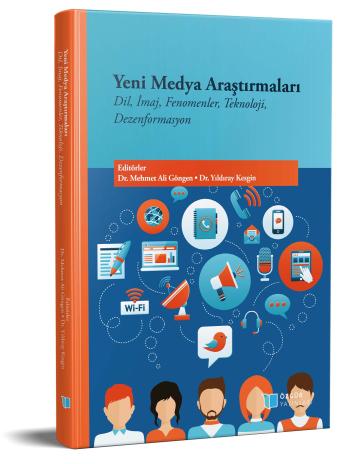
Yeni Medya Araştırmaları: Dil, İmaj, Fenomenler, Teknoloji, Dezenformasyon
İndir
Özet
İletişim Çalışmaları birçok alana değen çalışmalar olması nedeniyle interdisipliner bir alandır. Sosyolojiden psikolojiye, metin analizlerinden kadın çalışmalarına, kültür çalışmalarından siyasete, hukuktan sinemaya kadar çok geniş bir alanı kapsayan iletişim çalışmaları yeni medya ile bambaşka bir boyuta evrilmiştir. Sınırların ortadan kalktığı bu dijital toplumda iletişim çalışmaları alanı daha da genişlediği gibi, birtakım sorunları da beraberinde getirmiştir. Yeni medya özellikleri bakımından birçok yeniliği beraberinde getirmiş medyanın gücünü pekiştirmiştir. Eşzamanlı ve eş zamansız iletişime teknik anlamda güç katarak küresel iletişimi hem kolaylaştırmış hem de ucuzlaşmıştır. Bu da her yaştan insanın yeni medya ortamına iletişimsel içerikler üretmesine katkı sağlamıştır. Bu durum, devasalaşan bir sanal enformasyon bulutunu oluşturmuştur.
Yeni medya teknolojileri medya teknolojilerinin kullanımını kitlesel anlamda değiştirirken topladığı verileri çözümleme konusunda da oldukça yol kat etmiştir. Veri çözümleme ve analiz araçları insanlık tarihinde hiç olmadığı kadar gelişmiş ve daha da gelişme ibareleri göstermektedir. İnsanoğlu kendi içinden sayısal olarak belki milyarda bir çıkarabildiği bir zekayı, yapay olarak geliştirebilmeyi hedefliyor. Öğrenme aşkıyla yanıp tutuşan insanın yerine öğrendiklerini unutmayan yapay bir zekayı geliştirmeyi daha çok faydalı görüyor. Makine öğrenmesiyle enformasyon bulutunda bulunan bütün bilgileri çok kısa sürelerde öğrenen algoritmaları daha önce sorulup cevapları alınamamış soruların cevaplandırılmasında kullanmayı hedefliyor. Bu teknolojiler de günümüzde ilk kitlesel ürünlerini vermeye başladı. ChatGPT gibi yazılımlar topluma çok da yeni olmayan ancak daha pratik iletişim becerileriyle dolu bir iletişim ortamı sunuyor. Enformasyon bulutunu çözümleyen algoritma anlık ihtiyaca uygun metinleri kolaylıkla kullanıcıya sunuyor. Ancak unutulmaması gereken bir nokta var. Var olan içeriklerin çözümlenip yeni bir içerik yaratma konusu felsefik anlamda neyin yeni olduğunu sorgulatıyor. Örneğin Dadaizm akımı ortaya çıktığında var olana bir eleştiri sunarak yepyeni bir söylem tutturmuştu. Dadaizm tarihe adını altın harflerle yazdırdı. Algoritma üretimi, bir söylem olarak bunu gerçekleştirebilecek mi? Bu yaratıcılık sadece insana mı mahsus? Yeni bir şey söylemek yapay zekanın elinde mi? Bunları ise zaman gösterecek. Yeni medya teknolojileri ile ilgili sorular da dahil olmak üzere, elinizdeki bu çalışma, iletişim çalışmalarının bu interdisipliner özelliğini yansıtmakta ve bu yönüyle iletişim çalışmalarına katkı sunmayı hedeflemektedir.

